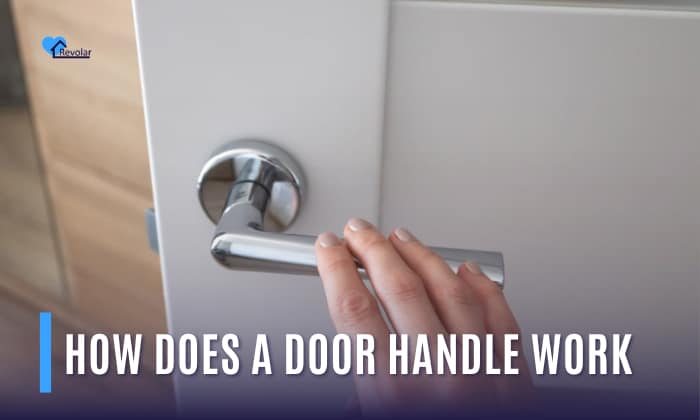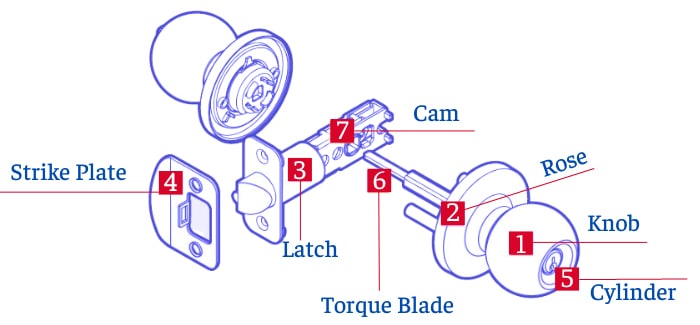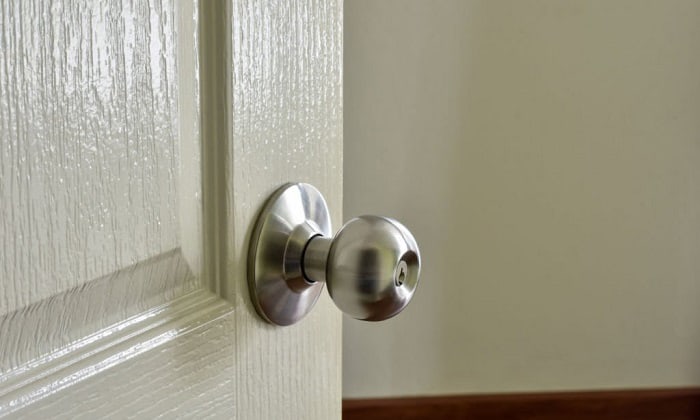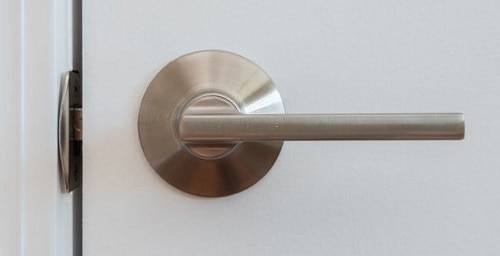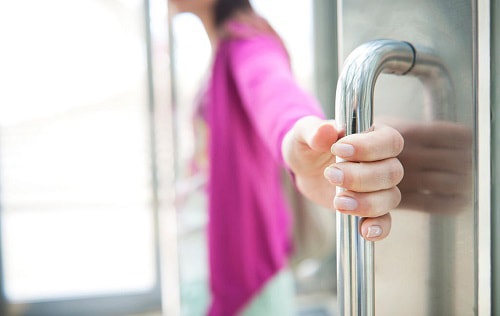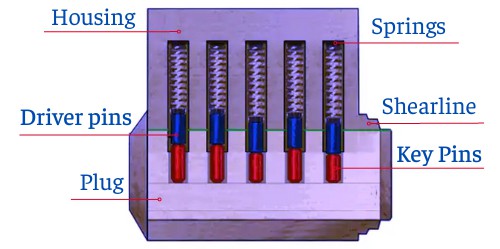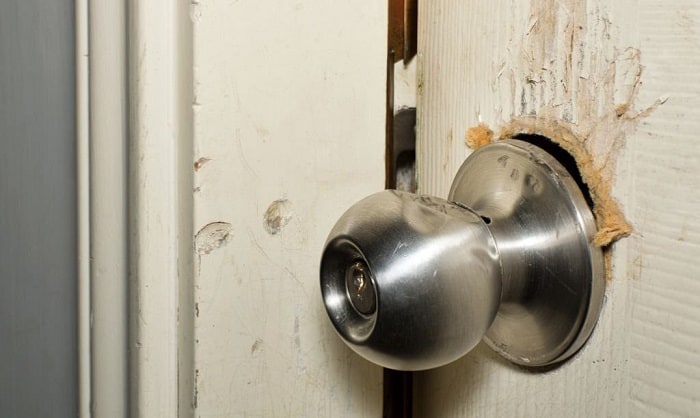In most cases, where and when you enter a room, you have to either push the door or pull it open. To make it easier for you, there come the door handles
Most door handles can be seen on the right-hand side or the unhinged side of the door. Depending on the make and brand of the door handle, each one has a unique way of opening the door for you.
How does a door handle work? Read on further to better your understanding of door handles.
Table of Contents
How Does It Work?
Depending on the type of door handle you have; each door handle differs in opening a door. Generally, when interacted with, a door handle disengages the locking mechanism inside the door to be pulled or pushed to create space to pass through.
Some door handles require it to be turned, while some door handles require pushing a button to open the door.
Typically, a door handle works by the manipulation of a mortice latch, and they are often a handle on either:
A door handle operates by manipulating a mortice latch, and they are composed of a handle on either:
- A plate
- A rose style
- Or a lever
The spindle in the handle drives the bolt across the internal face of the door as the handle is twisted. The bolt can slip in and out of the latch faceplate of the frame as a result of this motion. That allows you to open and close the door.
Refer to this diagram to know about its interior mechanism:
Components of a Door Handle
So what are the parts of a door handle called? For basic door handles, there are seven components inside and outside the door handle according to the door handle diagram — the lever, the spindle, the backplate, the rosette, the tubular latch, the strike plate, and the door lock.
1. Lever
The common lever that you see on door handles is a basic door knob. This is the most prominent part since it can be seen externally on the door handle faceplate.
2. Spindle
One of the parts of a doorknob assembly is the spindle. This metal rod connects both the handles of each side of the door and runs through the bolt latch.
When a door knob is turned, the spindle rotates, causing the latch bolt to retract and open the door. When the spindle is at rest, the latch bolt stays inside the strike plate, so the door will not open.
A door handle spindle is either 5mm or 8mm, designed for various door types.
3. Backplate
A backplate is one of the door handle pieces for lever-on-backplate handles. Opt for a backplate if you do not want a locking mechanism directly installed on your door handle or if you want to cover screw holes or marks on the door.
4. Rosette
A counterpart of backplates, a rosette or rose is used for lever-on-rose door handles. Since a rosette looks like a modern and minimalist style of a rose, it is popular in modern-style doors and homes.
5. Tubular latch
The tubular latch, or the door latch, is responsible for releasing or retracting the latch bolt. When a door knob is turned, the door latch retracts the latch bolt from the strike plate.
6. Strike plate
The anatomy of a door handle will not be complete without the receiving part, which is the strike plate. The strike plate is responsible for stopping the door from being opened when the latch bolt is resting.
7. Door lock
One of the popular names of door handle parts is the door lock itself. Door handles aren’t secure enough without a pin-tumbler lock keeping the door from being opened by unauthorized people.
Now that you are acquainted with the door handle part names, read on and know the types of door handles and how they work.
Types of Door Handles
There are three main types of door handle — lever handles, pull handles, and door knobs. Each of these types differ in the ideal application and opening mechanisms.
1. Lever handle
Also called door levers, lever handles are common since they are used both in residential and commercial purposes. Some lever handles are attached to a rose, while others are installed on backplates.
So how does a lever handle work? The lever handle is attached to a spindle connected to a latch bolt.
That is why when the lever handle is pushed down, the spindle turns and rotates a cylinder inside the handle. With the rotational force, the cylinder retracts the latch bolt from the strike plate, opening the door.
The latch bolt slides back when one lets go of a lever handle. When the door is closed, the latch bolt remains inside the strike plate, and the door remains closed until the lever handle is accessed.
Here are the pros and cons when you use a lever handle:
- Much easier to use than other handles
- Variety of lever handles to choose from
- Can accommodate a lock with a deep case
- Not as authentic as door knobs
- Require more maintenance
- Can get stuck often
2. Pull handle
Pull handles are commonly seen on doors that do not have sophisticated door locks and can usually be opened just by pulling or pushing the door. They are attached to doors where foot traffic is heavy.
There are not many working mechanisms to the pull handle. Depending on how the pull handles are installed, vertical pull handles and horizontal pull handles accommodate vertically opening and horizontally opening doors.
Since doors are vertically open, pull handles are usually installed vertically flush onto the door. Since most pull handles do not have a built-in deadbolt or latch bolt, a door remains open unless a separate locking mechanism is in place.
Here are the pros and cons when you use a lever handle:
- Wide space for grip
- Can be easily opened even if you have a wet or greasy hand
- Can be accessed even when both hands are occupied
- Pull handles can get caught on clothes or bags
- Might be more costly than other types of handles
- Can take more space on the door
- Door knobs
If you encounter a door handle that is round and turns counterclockwise and clockwise, then that is what you call a door knob. This type of door handle is commonly seen in internal doors.
The internal door handle mechanism of a door knob is much like lever handles — when the door knob is turned, the spindle retracts the spring bolt as it rotates, which in turn, opens the door.
Most door knobs that work as a lever have built-in locking mechanisms, making them easy to use. For example, if your door knob has a pin-tumbler lock, the doorknob will not turn unless the key for the lock is inserted and turned.
Here are the pros and cons when you use a door knob:
- Door knobs are compatible with older-period properties
- Antique door knobs are used for aesthetics
- Comes in different shapes
- Does not have much grip compared to other types of handles
- Knuckles might get caught on the door frame
- Difficulty in accessing the door knob if you have wet or greasy hands
Common Issues With Door Handle
Door handles are not susceptible to malfunctions. Here are some common issues that you might encounter when you access your door handle and how to fix them:
1. Stuck or broken key inside keyway
If you have a stuck or broken key inside a door lock mechanism, it might be difficult to access if the door handle is put in a locked position. Use a needle-nose pliers to pull out the remains of the key.
2. Door lock doesn’t latch
If your door handle mechanism is broken because the door lock doesn’t latch, it might be because of misalignment. Grab your screwdriver and tighten the screws on your door hinge to align the latch and the strike plate.
3. Loose door knob
Due to wear-and-tear, the pieces of a door knob might come loose. Grab your trusty screwdriver and fasten the fittings of your door knob to make it more durable.
4. Lock on handle is frozen
If your door hardware cannot withstand low temperatures, they can be susceptible to being frozen. To fix this, apply a lock de-icer to your door handle.
Tips to Beef Up Security
Your door handle might not be enough to fend off kick-ins or lockpicking. Here are some things that you can do to add another layer of security:
- Choose and install a more solid-core door.
- Tighten the hinges of your door.
- Buy a smart lock.
- Replace the strike plate of your door.
- Reinforce the door frame.
Conclusion
Now that you know the answer to the question “how does a door handle work?” and the types of door handle, you can now choose the best door handle option for your home and business.
Share these to your friends and family so that they can improve the security inside their homes, too!

I am the last member to join Revolar and might be just the luckiest to work with dedicated people like Teddy and John. Our team has established a process where my only job is writing the best content to deliver incredible ideas and guides.


